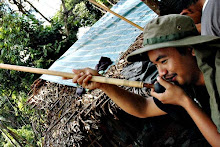What is shutter speed ? The aperture diaphragm of a lens (bigger or smaller values) AND timing (open and close) of the camera's shutter curtain - BOTH perform the tasks of regulating the amount of light entering the camera and expose onto the film. The shutter speed scales engraved on the shutter speed dial of conventional camera bodies with a shutter speed ring OR via some flickering digital numerals on the LCD screen like: 1/8000, 1/4000, 1/1000, 1/500, 1/250, 1/125, 1/60, 1/30, 1/15, 1/8, 1/4, 1/2, 1 or -1, -2 etc. are essentially indicators of the duration (timing) at which the shutter curtain opens up and closes during an exposure process. A 1/125 setting means the shutter curtain open and close within one hundred and twenty five of a second while 1 means an one full-second the shutter opens up during exposure to absorb the available light source onto the film to form an exposure.
Before the advent of LCD, multi-modes electronic SLRs such as Canon A-1 has a dual input dial for shutter speed (B) and aperture control (Green). But again it depends a lot on camera design. For an instance, ALL Olympus and mechanical Nikkormat SLRs have their shutter speed scales located just next to the lens mount, you have to make use of a grip designed to turn the scales (A) !
Again, NOT all SLR cameras have shutter speed selected visible from the top or the front, instead, changes and selection can only be viewed inside the viewfinder. A good example is this Pentax push button that controls (C) the shutter speed. But ALL these may not be applicable to a new wave of modern AF SLRs which use a different kind of input to control shutter speed in the camera. Most would have use thumb or finger wheel(s) such as illustrated earlier on the aperture control section. Well, it is hard to cover and satisfy everybody's desire all in a single page, and my prime interest is still to selling you the idea of how to make use of an old, cheap manual focus SLR of yesteryears. As for an modern AF SLRs, there are plenty of useful resource sites on the Net for you to browse through and gather such information. At this moment in time, I won't be able to offer too much of a help here in this site. But whatever it is, basic principle remains.
What does shutter speeds do ?
In principle, shutter speeds, like aperture value detailed on earlier section, contributing as the next half of the main components for any exposure process - the interval at which the shutter opens to allow a specific amount of light (also depends on the opening of the lens diaphragm) to pass through and expose the film inside..
Different selection of shutter speeds will yield different kind of visual effect on a final photograph. Generally, a fast shutter speed can freeze action while slow speed can blur your image. I am not indicating these are fixed rules. If you understand the nature of how various shutter speed(s) will affect an exposure, you may put them to creative use to enhance the effect - like other than freezing a fast action scene, a slow shutter speed can also put to good use in portraying movement. You can try on to "PAN" a moving subject by following its direction or simply generates a sense flow of movement. But MOST people relates SLOW means BLURRING AN IMAGE which leave little for them to select this alternative to try them out. Well, it is excusable because in most PR-type of photography (photo session on public relation matters like wedding, gathering, seminars, or personal domestic duties for some privileged group - includes your wife, mistress or girl friends..), who would appreciate a defocus or blurry images ? BUT - for the creative minded photographer, slower shutter speed sometimes may create a more powerful visual impact than images taken with action-freeze high shutter speed(s), say, a free flowing river, traffic, a flock of birds taking off or even speed-demons on a race track.. etc..

A basic mechanical SLR camera body like the Nikon F2S of the mid-seventies only offers manual exposure control. AE may require accessory such as DS-1 to transform it into an shutter priority AE camera.
However, by early '80 with development and refinement made on both cameras and lenses (Most would require a new series of optics), majority of them started to offer "Shutter Priority AE" and "Intelligent Programmed AE" as well.OFF-TOPIC SUPPLEMENTS: "Shutter Speed Priority AE": An exposure mode with an automatic or autofocus camera that lets you select the desired shutter speed; the camera will then set the matching aperture value for a proper exposure. If you change the shutter speed, or the light level changes, the camera adjusts the aperture accordingly "Aperture Priority AE": An exposure mode on an automatic or autofocus camera that lets you set the aperture while the camera sets the shutter speed for a proper exposure. If you change the aperture, or the light level changes, the shutter speed will change automatically. Apart from the sport or action photography, aperture priority is the most common & effective automatic mode used in photography. It can also explained as: An automatic exposure process in which the lens aperture is set by the photographer, and the camera sets the shutter speed. It can also be used in the stopped-down mode with any lens that does not interfere with the metering system e.g. bellow unit or non-auto extension rings etc. "Programmed AE": An exposure mode on an automatic or autofocus camera that automatically sets BOTH aperture and shutter speed for a proper exposure. "Intelligent / Flexi-Programmed (flexible-Programmed Auto) AE": The camera's electronic circuit will de
Friday, February 12, 2010
WHAT IS SHUTTER SPEED
Subscribe to:
Post Comments (Atom)













No comments:
Post a Comment